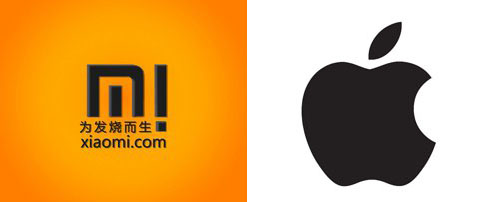Xiaomi or Apple – two innovation strategies for China
- By John Ross
 0 Comment(s)
0 Comment(s) Print
Print E-mail China.org.cn, April 13, 2015
E-mail China.org.cn, April 13, 2015
"Innovation" certainly will continue to guide China's successful economic strategy for the next few decades. However some of the discussion fails to understand the core of this issue, imagining that its key lies in matters such as "greater creativity in schools."
In fact, there are two fundamentally different types of innovation. The first is "cost innovation" – the use of technology, managerial strength, etc. to reduce costs. The second is "product innovation" – the introduction of entirely new products such as the iPhone, iPad, Apple Watch etc. And it's the former that will be the key for China for the next several decades.
|
|
|
The logos of Chinese smartphone company Xiaomi Inc. (L) and American company Apple Inc. |
Two extremely successful smartphone companies, Apple and China's Xiaomi will illustrate this.
To understand different innovation strategies in fundamental economic terms, there are two ways to maintain a competitive advantage as productivity increases:
? The same product can be produced at a cheaper price.
? The price can be kept the same and a superior product produced.
Apple best exemplifies the second approach. Apple's general policy does not reduce prices on new products – when it has done so, as with the cheaper iPhone 5c, it has generally failed. Apple's strategy is to continuously produce greatly improved, best of all entirely new, products – the iPod, iPhone, iPad, etc. This strategy of "maintain the price, raise the quality" is therefore accurately termed "product innovation."
Xiaomi is an outstanding example of the other strategy, "cost innovation." Xiaomi is the world's most valuable start-up with a value of over $40 billion. Xiaomi does engage in some product innovation – its use of social media, its timing of product releases etc are superior to Apple. But the fundamental competitive advantage of Xiaomi is price and value. Xiaomi produces a product which in quality, is comparable to the iPhone but for less than half the price.
Success in this strategy does rely from an engineering standpoint on the quality of the product. If the quality of Xiaomi's phones was only 50 percent of Apple's, then, even selling at 50 percent of the price would offer no competitive advantage. It is only because a Xiaomi phone does deliver more than 90 percent of the functionality of an iPhone for less than 50 percent of the price that Xiaomi has a competitive edge. But this does not alter the fact that the fundamental advantage of Xiaomi over Apple is cost not a better product – exemplifying "cost innovation."
This difference determines the strategy of the two companies – including marketing. Xiaomi's style of launching products is similar to Apple – even to the type of clothes of Xiaomi's CEO Lei Jun resembling those of Steve Jobs. This led to foolish Western criticism of Xiaomi, but in reality it illustrates the company's strong strategic sense.
If a company's strategy is product innovation, the emphasis must be on how different its product is to any previous one. The classic visual expression of this was the advert announcing Apple's Macintosh computer at the 1984 Super Bowl – the most famous single advertisement ever. This showed a woman in brightly colored clothes smashing the grey images of a uniform totally regimented society – a visual interpretation of the message "the Macintosh is like no other computer before, it is vastly more individual and creative."
But if the strategy is cost innovation then, with relatively advanced technological products such as smartphones, marketing must focus on how similar the cheaper product is to the more expensive one – ideally there should appear to be no difference except price.
The reason for this is that the immediate suspicion of any customer who sees a product only 50 percent of the price of another is that this is because it is only 50 percent of the quality! Therefore everything must be done to remove this prejudice.






